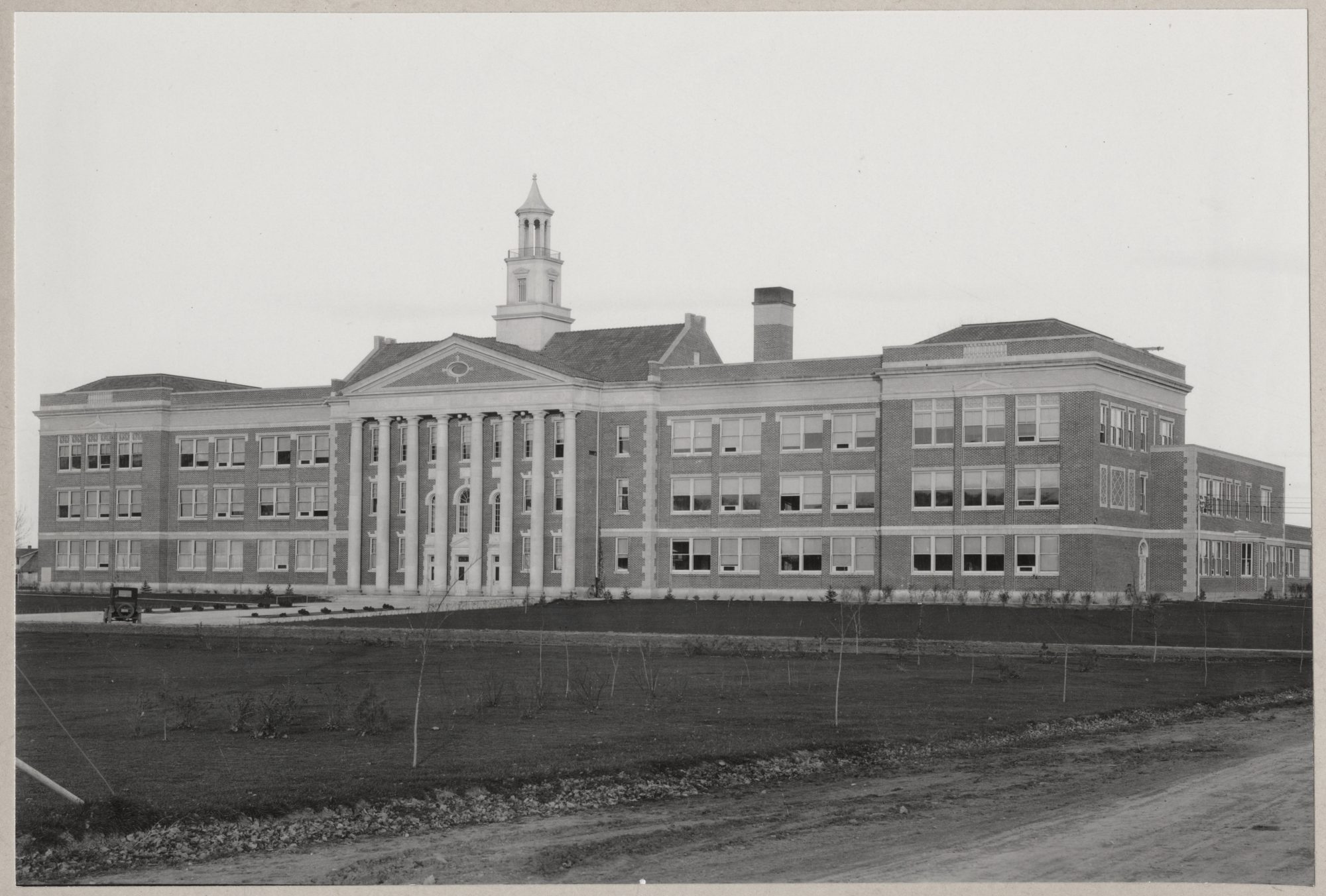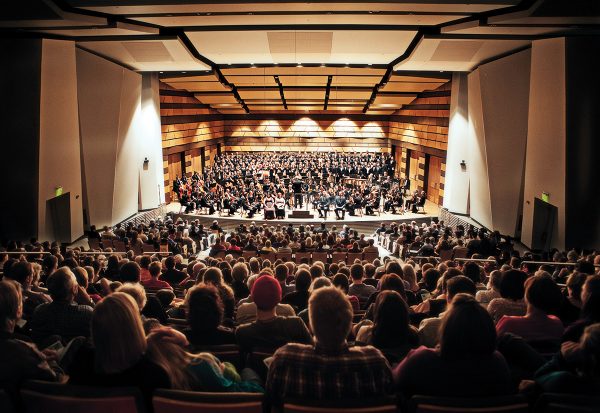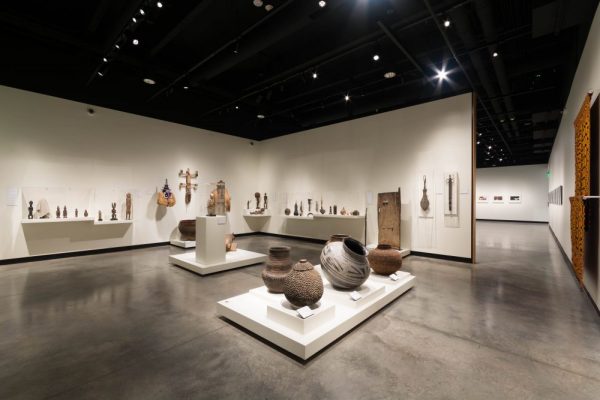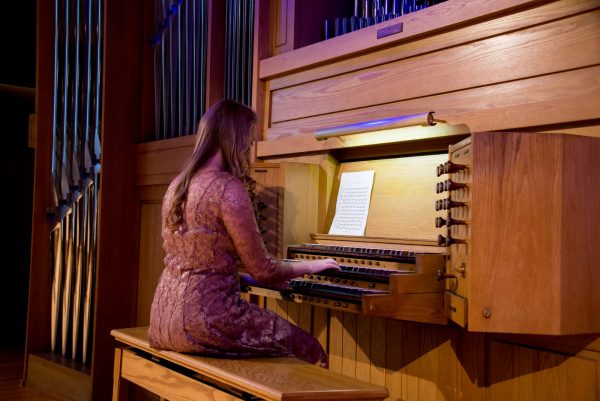Clean, white pillars stand stoically against a red brick façade. Renaissance-era oil paintings hang in quiet galleries. The lively notes of a Vivaldi concerto drift up twisting wooden staircases. This is not the glass and steel monolith one might picture as a 21st century arts complex.
Yet within these nearly century-old walls, world-class facilities are giving classic works of art a new life. The historic building, which at first glance could be dismissed as a relic, has become the high-tech heart of Colorado State University’s thriving arts scene.

Renewing a Fort Collins landmark
Built in 1925, the 225,000 square-foot facility that now serves as the University Center for the Arts was originally constructed as Fort Collins High School. The Lambkins enjoyed a 70-year run in the facility, but by 1995, the student population had outgrown the historic building. The space that held memories for many Fort Collins residents was in need of renovations and a new purpose.
Around the same time, students, faculty, and administrators at CSU began to call for a renewal of the arts. While music, theatre, and dance had a rich history at the University, upgraded spaces were needed to elevate the performing arts to the next level. CSU purchased the historic high school and funded a 45-million-dollar renovation through a combination of student fees, donor gifts, and University resources.
"We are deeply grateful to these donors and to the students of Colorado State for funding the University Center for the Arts," said Ann Gill, former dean of the College of Liberal Arts, at the UCA’s Grand Opening. "We now dedicate ourselves to the challenge of taking the arts programs and performances to amazing new heights. Everything we achieve in this new space will be in honor of their investment in our future."
In 2008, the University Center for the Arts opened its doors with five world-class performance venues, classrooms, rehearsal spaces, labs, teaching studios, and administrative space. The visual arts were also represented in the space with two museums.
“In the end, in order for us to have a true university arts center, it had to include a space for the visual arts,” said Bob Hoffert, former acting dean of the College of Liberal Arts.


Cutting-edge features
The University Center for the Arts was designed with the future in mind. Twenty-first century technology was incorporated throughout the building to provide an optimal environment for learning, exhibition, and performance.
The 550-seat Griffin Concert Hall includes some of the most advanced acoustical design features in the region, including articulated walls, ceiling clouds, and raked seating. The University Dance Theatre is equipped with a full range of theatrical audio-visual and lighting systems. The fully sprung dance floors are ideal for ballet and modern dance, reducing injury risk and enhancing dancers’ performances. The 300-seat University Theatre is a trapped thrust stage theatre, creating intimacy between actor and audience with its three-quarter-round stadium seating.
Both the Avenir Museum of Design and Merchandising and the Gregory Allicar Museum of Art have implemented leading-edge technology to preserve their collections. With museum-standard climate control systems, lighting, and security, the spaces are designed to safely exhibit works of art at ideal temperature and humidity levels. A temperature- and humidity-controlled storage facility behind the UCA houses an additional 15,000 artifacts from the Avenir and Allicar collections.
In 2017, the Allicar Museum achieved accreditation by the American Alliance of Museums, one of only 24 museums in Colorado to receive the national recognition. In the letter notifying the Museum of its accreditation, the AAM Accreditation Committee stated: “The museum is an excellent example of how a departmental gallery can grow into vibrant museum thanks to a clear vision, a strategic plan that marries the accreditation goal with its new location, strong financial and administrative support from the University and the community, and a dedicated professional staff.”
Elements of history
While the comprehensive renovation created a facility that rivaled any modern arts complex in the country, the character of the space is shaped by classical features. One historical highlight is the University’s Casavant Frères Organ, originally built for CSU in 1968 under the direction of emeritus organ professor Robert Cavarra (deceased). Boasting 2,079 pipes, the organ was constructed in a style emulating 17th and 18th century German organ building principles. The instrument, internationally known as one of the finest organs built in the 20th century, is now housed in its own 275-seat recital hall.
“We’re trying to keep the legacy of great organ playing alive and well,” said Joel Bacon, associate professor of music at CSU and Stewart and Sheron Golden chair of organ and liturgical studies. “I’m hearing some of the best organ music I’ve heard in my life out of young organists, and that’s exciting.”
In 2014, the Gregory Allicar Museum of Art became the permanent home of the Hartford-Tandstad Collection. This collection contains approximately 200 works by pivotal figures in European art history, including drawings, paintings, sculptures, and decorative arts dating from the late Renaissance through the 19th century.
“I hope all the [students] at the University will be able to have this as a learning tool,” Larry Hartford said in an interview before his death in 2011. “Then, I will feel my life was worthwhile.”


The future of the arts
In 2018 the University Center for the Arts celebrated its tenth anniversary. Over the past decade it has become a fixture of both the Colorado State University campus and the Fort Collins community. Alongside community programs like the Music District and Bohemian Nights, the UCA has contributed to a collaborative and flourishing Fort Collins arts scene.
Recent gifts from generous donors have allowed the UCA to install $1.5 million in technology upgrades to the five live-performance spaces. The venues are now equipped for audio recording, livestreaming, projection, and live-sound capabilities, making possible the live production of jazz, rock, pop, and hip-hop.
“These upgrades promote diversity of musical cultures by providing the capability to utilize state-of-the art amplification,” said Dan Goble, director of the School of Music, Theatre, and Dance.
This spring, these spaces will host diverse performances, including traditional chamber music, original contemporary choreography, and the work of an acclaimed modern playwright.
In April 2020, the Gregory Allicar Museum of Art will present MIIX, Multicultural, Intersectional, Inclusivity eXchange, a forum to discuss representation and practical change related to social justice. Established in 2018, this annual program examines the role that museums have played as gatekeepers of culture, often replicating the barriers to minorities in society. Using the visual arts as a catalyst for discussion, participants seek to answer the question, “How do we affect change?”
As the arts community continues to evolve, the UCA stands poised to educate and inspire a new generation. At the intersection of its modern learning spaces and rich, historical details are the young artists who will shape our culture in the 21st century. Their diverse voices and perspectives will continue to bring new life to the historic spaces of the University Center for the Arts.
